Working with found natural and discarded debris, Canadian artist Susan Coolen creates elaborate collections that reflect a myriad of interpretations. The COMP Magazine caught up with this longtime friend in the New Year to speak about the role of the artist as scavenger, her “LITTER-ARTI” projects, and why what people often overlook or throw out can offer insight into the present.
Can we start with a little background? You grew up in Nova Scotia, studied in Chicago, and have lived in Montreal and the Toronto area (Toronto Island and Kitchener-Waterloo). Can you describe how place has effected your artistic practice?
![Susan Coolen, The ANTLERS Project, found sticks [in situ documentation], 2012](http://www.thecompmagazine.com/wp-content/uploads/2015/01/2012-stick-antlers.jpg)
Susan Coolen, The ANTLERS Project, found sticks [in situ documentation], 2012
Found objects are my working materials and so, by extension, one might say that ‘place’ is the underpinning of my art, with the above-mentioned urban and rural environments providing me with a never-ending source of detritus and nature specimens. There is incredible overlap of natural in the urban and man-made in natural habitats, each providing me with many unexpected ‘finds’. I delight in those unexpected finds, as I get to know a place and what is particular to it, I am also able to search out specific items once an idea has taken place and I want to expand on that work.
During your career, you have frequently used scavenging as a process in your oeuvre. Why are you drawn to this? What are some of the items you have collected? How do you transform these discarded materials into realized works?
Scavenging does play an important part in that it keeps my eye to the ground and always alert to form and pattern, even when I am not consciously looking. When I am in Nova Scotia I go on specific shoreline walks, as I did as a child, to see what has washed ashore. I often find sun bleached bird skulls, stingray egg pods, swaths of fabric-like seaweed and floatable ocean debris. I know the smell of a seal carcass and can follow that scent until I find it. Depending on the state it is in, I may be able to take bones or if not, I make a cairn of rocks on top of it and come back to it at a later date. On Toronto Island I’ve found animal skeletons under buildings, sticks in park areas, and artifacts along beach lines. Montreal has a profusion of lovely objects left as take-able refuse in back lane ruelles. In all of the major cities there is an abundant amount of tossed and blown about detritus and an ample supply of small road kill [and cat kill !] along streets, and so I always carry gloves and plastic bags for whatever I may find !
Though I do photograph in situ as a reference, all of my finds are brought back to the studio. I mummify the small animals and I have had urban and rural bone yards so the insects can clean the bones. I have used the scanner to photograph many of these finds, and now use photography as a means to advance to graphic work. This in turn enables me to shift the original photographic image into any number of other possible mediums: works on paper, drawings, graphic works, video-animation, projections, artist books, installations and interventions in the environment. I am interested in collections, order, organization, form and pattern and use my found materials to visually explore and express these interests.
What is interesting to myself is that, after years of working photographically and though the scavenging, gathering and organizing aspect of my practice remains constant, I have a huge impulse towards graphic form, returning me to my original profession as a graphic designer in the 1980’s, while retaining and expanding on my underlying interests with new explorations.
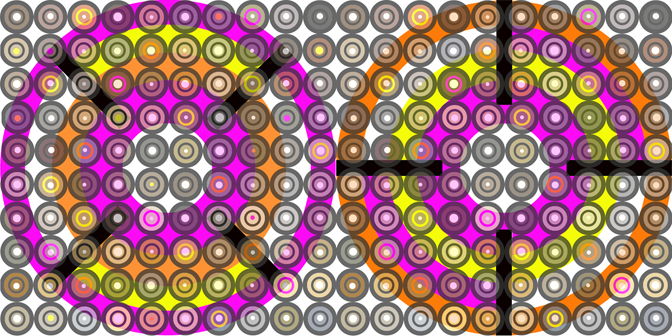
Susan Coolen, TARGET PRACTICE, graphic work from photo documentation of individual city tree stumps, 2013.
What are the LITTER-ARTI Projects? You’ve been working on different elements at four locations: “50 Ways to Leave Your Litter” (Kitchener), “Lake Effect” (Toronto Island), “Gone with the Wind” (Chicago), and “Lovin’ Spoon-full” (Wales).
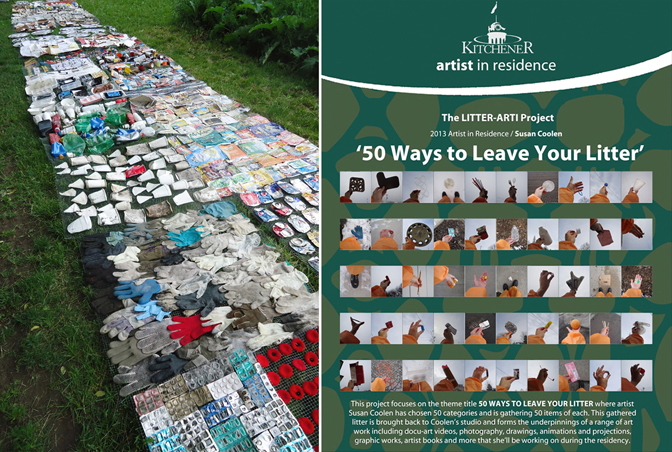
Susan Coolen, The LITTER-ARTI Project: carpet of litter from “50 Ways to Leave Your Litter”, poster, 2013.
The LITTER-ARTI Projects have gradually developed out of the shoreline and urban scavenging and is a response to the discarded and ubiquitous debris in any and all environments. In 2013, I was selected as the artist-in-residence for the City of Kitchener, Ontario in support of my proposal for a LITTER-ARTI Project in the city. The residency mandate aims to engage the public through realization of a self-directed artist project and this was my first project of this scale and duration. During the calendar year I was able to immerse myself in this project, developed the theme “50 Ways to Leave Your Litter”, decided on 50 categories of litter and began walking city streets to collect 50 items of each category. I mapped my walks, photographed in situ and began to produce a voluminous body of work that was presented throughout the year at public events and at city hall gallery spaces.
![Susan Coolen, The LITTER-ARTI Project, sample covers and inside pages from the ’50 Categories’ booklet series [a booklet for each of the above 50 categories of litter, and 50 graphic images in each].](http://www.thecompmagazine.com/wp-content/uploads/2015/01/2013-litterarti_50-categories-booklets-01.jpg)
Susan Coolen, The LITTER-ARTI Project, sample covers and inside pages from the ’50 Categories’ booklet series [a booklet for each of the above 50 categories of litter, and 50 graphic images in each].
![Susan Coolen, The LITTER-ARTI Project, video-animation projection on city hall CUBE [graphics from ’50 Categories’ book works], 2013.](http://www.thecompmagazine.com/wp-content/uploads/2015/01/2013-litterarti_animation-on-the-Cube-.jpg)
Susan Coolen, The LITTER-ARTI Project, video-animation projection on city hall CUBE [graphics from ’50 Categories’ book works], 2013.
My own interest was in the graphic patterns and forms of the items I found, while at the same time allowing the public to see my artistic process and progress during the year and to also engage with the physical nature of the debris I had collected. Displays included a 50 ft long ‘carpet’ of the collected litter, large exterior projections, documentary and video-animations, graphic artworks, artist books, and installations. The year-long project culminated in a public artwork permanently placed in one of the city’s community centres.
I’ve also started 3 other LITTER-ARTI Projects and each is in various stages of production. ‘Lake Effect’ concentrates on the recreational items … balls, badminton birds, fishing bobs and floats, toys, water bottles, plastic utensils and more … that wash ashore on the beaches of Toronto Island. These works are currently developing as graphic works and book works. I’ve started a project for Chicago called ‘Gone with the Wind’ and on a number of trips to Chicago I have started photographic and video work of newspapers tumbling and blowing around in the downtown core. I’ve also been able to do most of a ‘50 Ways to Leave Your Litter’ version of Chicago’s litter. And I have documentation of a myriad of strewn white paper plates that must have blown out of a supply van and were lined up and down the sidewalk like giant white polka dots. So I expect to use those photographs as a starting point for video-animated works. And finally there is my initial collection of colourful plastic and wooden fast-food utensils found during a visit to Wales, and its LITTER-ARTI title “Lovin’ Spoon-full” references the traditional Welsh craft called lovespoons, and graphic work will develop out of that connection. [it may be worth noting that these projects are connected to my earlier photographic projects that use some form of found ‘trash’: ‘Piece Work’, where I collected thousands of discarded dish shards and artifacts thrown into ocean bays in my childhood village, ‘Pliez’ which is my ongoing collection of over 200 found paper planes from numerous cities [Montreal, Chicago, Toronto, Halifax, Jupiter, Kitchener-Waterloo, Barcelona, Llangollen] and ‘Float’, the collection of washed up balls from Toronto Island.]
Can you offer an introduction to the project “Neon/Wood” began in the fall of 2014? What is the intent of this effort? You plan to present this in 2015. Have you secured a location? What materials are you working with? Can you share your process?
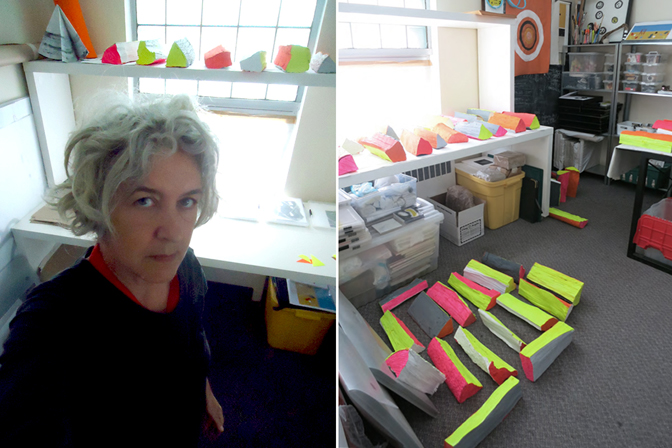
Susan Coolen in her studio, with ‘Neon/Wood” in progress, 2014.
“Neon/Wood” is initially an exploration that popped out of my documentation of hundreds of urban tree stumps [see above image ‘Target Practice’]. I’ve been making new graphic work based on the target-like tree rings and noting the neon colours used to mark city trees for removal, etc. I brought some pieces of firewood back to the studio and began to paint them, and to do neon graphic and paper works based on the rectangular and triangular forms of the wood surfaces. I collaborated with a downtown business to present 50 pieces of the neon wood hanging from the ceiling of their wood-fired-oven eatery. This suspended installation displayed during Kitchener-Waterloo’s 2014 cultural event ‘Night/Shift’ in late November and is now a permanent art work, visible inside and outside. I’ve since been asked to present another “Neon/Wood” installation at the Gibraltar Point/Artscape site on Toronto island in May, 2015. The process is fairly simple … split firewood is painted white, then in neon colours [using acrylic paint so that it is always reusable as firewood]. During preparation of this second installation project I’ll be continuing to work through graphic explorations and expand to folded paper works, animated video work and percolate on large wall works and smaller book works.
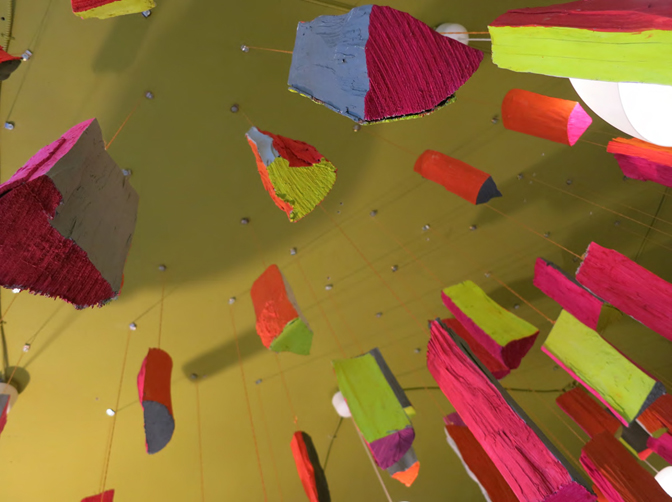
Susan Coolen, “Neon/Wood” installation detail, 2014.
What other plans do you have for the future? Are there any “dream” projects that you would like to attempt in the future?
I am most interested in having my work exhibit and circulate in the public realm, so I am very pleased to have just received an arts grant to produce a ‘LITTER-ARTI Library’, which is a 50-book work set of the graphic imagery from my litter categories, as well as companion books that document the explorations and events of that LITTER-ART Project. These ‘library’ sets will go to the Kitchener Library, the City of Kitchener’s public art archives, the Waste Management Education Centre and a Community Centre [which houses the public art acquisition from the LITTER-ARTI Project].
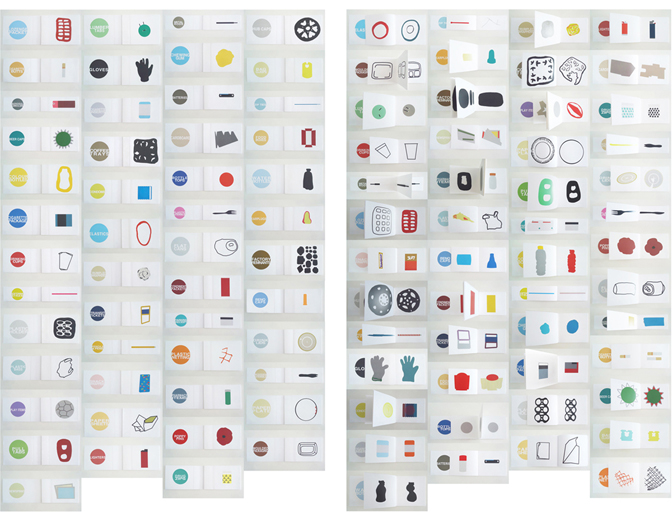
Susan Coolen, ’50 Categories’, selected inside pages from the 50 booklet series, 2013.
![Susan Coolen, : “(an incomplete) MUSEUM (of categories) for the FUTURE”, new works-in-progress: mummified birds in wax and clay, bird bones in clay, mummified mouse [black], voles [red] and baby rabbits [yellow] in clay, 2014.](http://www.thecompmagazine.com/wp-content/uploads/2015/01/2014_museum-for-the-future.jpg)
Susan Coolen, : “(an incomplete) MUSEUM (of categories) for the FUTURE”, new works-in-progress: mummified birds in wax and clay, bird bones in clay, mummified mouse [black], voles [red] and baby rabbits [yellow] in clay, 2014.
I’m also now working on yes, a dream project, called ‘(an incomplete) MUSEUM (of categories) for the FUTURE’. This is an extensive approach [in its early stages] intended to gather up my various collections into a series of new museum-like installations for a gallery space, and also to document companion interventions where I preserve and bury selected collections in rural and urban locations as a kind of time-capsule for the future. I’ve been working with clay, insulation foam, wax, duct tape, and more … coating bones, nests, snowballs, snakes, caterpillars etc. I am colour-coding some specimens for display, preparing others for interventions in the environment and making codex-inventory drawings of all prepared specimens and collections. These works on paper make artistic note of the ‘faux museum’ categories and also are preparatory drawings for new graphics works. These graphic works will form the basis of a companion ‘library’ for the project. As with most of my work, this project has many layers and connections to the smaller projects that are always on the go in my studio, and so the library component could become not only a book work but the beginnings of a reference dictionary of imagery for new work [wall works, projections, posters]. It is probably the largest project I’ve attempted, and already is full of surprises and challenges. But is exciting to begin the work and to also percolate on how I will advance it, where I might place it and what new ideas it is likely to spark during all of this.
Susan Coolen lives and works in Kitchener-Waterloo, Ontario, Canada. Coolen’s work has been presented at the Canadian Museum of Nature (Ottawa, Canada), Metrònom (Barcelona, Spain), Harbourfront Centre (Toronto, Canada), and the Mount Saint Vincent University Gallery (Halifax, Canada). When not braving the winds of the north, Coolen is sifting through detritus in search of obscure artifacts for her curious collections.
Additional information on the artwork of Susan Coolen can be found at:
Susan Coolen – www.susancoolen.com
Youtube Interview with Susan Coolen – https://www.youtube.com/playlist?list=PL-8QWaYyA3x6-9P_D8MOyPDkVAbHZIaqn
Susan Coolen Primoridia – http://www.cafka.org/cafka04/susan-coolen-primordia
The Litter Arti Wales – litterartiwales.blogspot.ca
Interview by Chester Alamo-Costello


